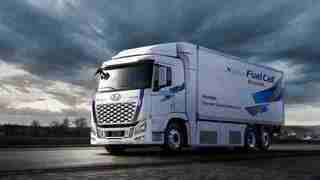New micromobility coalition aims to create simple and consistent pan-European policy
This article was originally published by Christopher Carey on Cities Today , the leading news platform on urban mobility and innovation, reaching an international audience of city leaders. For the latest updates follow Cities Today on Twitter , Facebook , LinkedIn , Instagram , and YouTube , or sign up for Cities Today News.

Eight of Europe’s leading micromobility companies have created a coalition to address what they say is “a gap in the representation of industry” in transport and mobility policy discussions.
Micro-Mobility for Europe (MMfE) — which comprises Bird, Bolt, Dott, FreeNow, Lime, TIER, Voi, and Wind — plans to contribute to the development of a “coherent policy framework” in Europe that will ensure micromobility solutions grow in cities and support the rapid transition to zero-emission urban mobility.
The group says it will bring the views, expertise, and experience of the shared micromobility industry to policy discussions and “transform urban mobility” across the continent.
While not specifying whether it intends to engage with individual cities or governments, TIER’s Head of Public Policy Jinél Fourie told Cities Today the group wants to “have a voice” in EU policy-making.
“EU-wide regulation will enable European cities to optimize the benefits of shared micromobility, as they transition to more sustainable modes of transport,” said Fourie.
Coherent Policy
As e-scooter and shared bike schemes have expanded across Europe, often appearing overnight with little consultation with city authorities, tensions have arisen regarding regulation and management.
In October, Copenhagen banned scooters from its streets after complaints from the public about poorly parked devices blocking access for elderly and disabled residents.
Many countries, however, including Ireland and the UK, have been slow to react to the new modes of mobility, relying on outdated legislation to govern their use.
The UK legalized the use of rented e-scooters in limited trials last summer, but issues with riders operating private scooters illegally are still widespread with little or no enforcement in many cities, including London.
Data governance
The eight members of MMfE currently operate in over 20 EU countries across more than 100 cities and have identified data governance and the circular economy as top priorities to ensure that shared micromobility is an integral part of EU policy developments in the coming years.
At the municipal level, some European cities have already adopted templates for data-sharing for providers of dockless bikes, e-scooters, and shared-ride providers that work within the public right of way.
In 2018 Lisbon integrated the Mobility Data Specification (MDS) – a city-led data standard originally developed by Los Angeles – into its transit ecosystem in an effort to create an open system of data-sharing for firms operating in the city.
SHIFT is brought to you by Polestar. It’s time to accelerate the shift to sustainable mobility. That is why Polestar combines electric driving with cutting-edge design and thrilling performance. Find out how .
Lowering the age of a licence won’t solve the truck driver shortage
Think back to when you were a kid, and people asked what job you wanted to do when you grew up. Did you say a truck driver? Well, now, once you turn 18, you can become one.

But why would you want to?
The Developing Responsible Individuals for a Vibrant Economy (DRIVE-Safe) is changing to allow 18-year-olds to drive trucks across states. While 48 out of 50 US states currently allow 18-year-olds to obtain a Commercial Driving License until federal law is changed, they cannot drive a truck across state lines until they are 21.
As a result, transportation secretary Pete Buttigieg will create an apprenticeship program for young truck drivers by Jan. 14, 2022. The apprentice truckers will be required to drive 240 hours under the supervision of an older driver in a truck equipped with safety features like automatic brake systems and a 65 mile per hour speed governor.
But who wants to be a truck driver, and who wants to be mentored by some grumpy dude? A 2019 survey put “YouTube star” as the dream job of kids . I’m not sure if the COVID-19 lockdowns have done anything to dissuade them.
But who wants to work as a truck driver?


The idea of on-the-job training sounds excellent. But I’m also not sure truck drivers are all that keen to act as master apprentices to kids. CDLLife posted a poll on the topic on the CDLLife App .
Out of more than 1,000 responses, 83% of drivers were against lowering the interstate driving age to 18. The idea of mentoring kids with no real financial benefits is also pretty unappealing.
But the reality is that trucking is an industry that struggles to attract young talent. According to the International Foodservice Distributors Association, the average age for truck drivers in the US is 46 years old, meaning companies face a retiring workforce.
This is not a problem limited to the US. Research in Europe by the IRU finds that the European supply of drivers currently meets an employment demand of 79 percent, leaving a visible driver shortage of 21 percent. Some 40 percent of truck drivers expect to retire by 2027, creating a shortfall of around 185,000 drivers.
Brexit: a perfect storm for what happens when there’s a driver shortage
We only need to look over the pond to the UK to see what happens when there’s a people shortage. After the Brexit vote, an estimated 20,000 truckers went back to Europe and never returned.
Industry officials claim the UK is around 100,000 truck drivers short, leading to problems like supermarket stock and fuel shortages.
The U.K. is currently around 100,000 truck drivers short, according to industry officials.
In response, the UK government offered temporary visas to European truck drivers, a deal few took up.
Why would you want to work up until Christmas for a country that told you to go home?
Worse, in a poorly paid role, where you spend most of your life on the road. You have limited social connections and even more limited access to bathrooms on the job. Just so other people can buy their Christmas presents or add fuel to their car.
The government ended up getting the army in to drive fuel tankers. That’s one use for people’s tax dollars.
Driver shortages are indicative of bigger industry problems
But back to North America, where some are questioning the hand wringing about a driver shortage.
Industry publication Freight Waves believes that truck driver numbers are up from pre-COVID days. They assert that the news around truck driver shortages distracts from the bigger issue of worker conditions and worker retention, noting that drivers are concerned about parking and pay, an issue ignored by larger carriers who only talk about the driver shortage.
The Owner-Operator Independent Drivers Association takes an equally nuanced stance, saying truck drivers are :
They contend that the supply chain shortage is symptomatic of a bigger issue:
The solution is remote and autonomous trucks
Let’s go back to those YouTube kids. If you want to get kids involved in heavy freight, look at Einride , who have created electric truck pods without a driver’s cab that drivers remotely control. That’s a good use for the stellar hand-eye coordination of a long Twitch stream.
I believe we will see driverless trucks will be routinely transporting freight on public roads. It’s already happening at a lesser rate on worksites with all truck manufacturers engaged.
In terms of autonomous truck startups, key players include Embark , Plus.ai, and TuSimple, and Waymo. Gatik recently gained attention this month as the first use worldwide of an autonomous middle-mile truck running without a safety driver in the driver’s seat. The trucks run products from a Walmart dark store to a Neighborhood Market.
The routes are fixed and repeatable , two trucks move at speeds up to 72 kmph, making between four and six total runs a day.
Ultimately, without a substantial improvement in the work-life of truck drivers, there’s little incentive for anyone to enter the industry. Lowering the licence age will only invite people to join a sector already plagued by challenging working conditions and pass the problems to the next generation
How much does it cost to buy, own, and run an EV? It’s not as much as you think
At the start of 2021, Norway broke records when it announced that electric vehicles officially made up over half of its automotive market share. Now that legacy car companies, like Volvo, are putting out more and better EVs, the market demand has never been higher.

Some of the new EVs on the market, like the Polestar 2, make the sputtering, petrol-powered cars of today look like a relic of the past. As such, you might be thinking about making the switch yourself. Currently, a good portion of the EVs on the market are branded as “luxury vehicles”, and indeed there is a luxury to having a smooth, silent ride. But this, and the appended price tag, tend to give potential EV buyers pause.
In the long run, EVs are not as expensive as you might think . Charging a battery is far cheaper than filling a tank and maintenance costs on petrol-fueled cars far surpass their electric counterparts. And as more countries double down on sustainability and carbon emissions pledges, you can expect more government subsidies that will take the initial edge off buying an EV.
So, how much does it really cost to buy, own, and run an electric car? Let’s break it down using the Polestar 2 as a case study.
How much does it cost to “fill up”?
The cost of charging an EV differs depending on where you live. Based on the global average electricity cost , charging a Polestar 2 could be about $11. In Europe specifically, where the average cost of household electricity is around €0.21 per kWh, you’re looking at something in the range of €16 to €24 to fully charge your battery, according to Polestar’s charging calculator . That’s about a third of the cost for the average European driver to fill up a small petrol-fueled car once a week, which is about how long a charge will last you anyway!
What is the Polestar 2’s cost-per-mile?
Calculating the cost per mile of an EV will depend on the cost of electricity as well as the efficiency of the vehicle. The Polestar 2 earns a rating of 37 kWh per 100 miles . If we use the European average cost of household electricity, the Polestar 2 has a cost-per-mile of about €0.08. For comparison, one of Europe’s most popular cars, the Renault Clio, is a petrol-hybrid vehicle, and it costs on average €0.61 per mile.
How does the Polestar 2’s running costs compare to a typical ICE vehicle?
Sometimes, car buyers are dissuaded by the higher initial upfront costs of EVs when compared to ICE vehicles. But in the car’s lifetime, electric will end up being cheaper due to a range of factors. Refueling and maintenance costs for EVs are much more affordable than ICE vehicles, and governments around the world are offering subsidies and tax incentives to encourage more people to buy electric, which definitely helps bring the cost down.
According to a 2020 study from UK insurance company Direct Line, the annual running costs average £1,742, or £33.50 per week for an electric car, which is 21% cheaper than the running costs of an ICE car, which is £2,205 per year, or £42.40 per week.
For the sake of comparison, let’s look at how the running costs of the Polestar 2, which won Germany’s Luxury Car of the Year in 2020 , stack up against a typical ICE Vehicle and a typical luxury ICE vehicle.
In terms of pricing, the Polestar 2 starts at €52,700, compared to a typical fuel-efficient ICE car which can be around €20,000, or a typical luxury ICE vehicle at around €30,000. If averaging about €18 per week in charging costs for the Polestar 2, the total annual cost of fueling could be around €930, compared to €1,050 for a typical ICE vehicle and €1,500 for a luxury ICE vehicle.
Maintenance costs are also far lower for electric vehicles in general, and the Polestar 2 in particular, which comes with free scheduled maintenance for the first three years of ownership, or 31,250 miles, whichever comes first. Polestar also offers all cars an eight-year, or 100,000 miles, battery warranty. According to a 2020 Consumer Reports finding, EV owners actually spend half as much on maintenance as their ICE counterparts.
Another way to reduce the overall cost of your EV is to look for government incentives and subsidies, which are plentiful in Europe . In Germany, for example, certain EVs can be funded with up to €9,000 for purchase, leasing, or financing by the Federal Office for Economics and Export Control. In addition, EVs that have been registered by December 31, 2025, are exempt from the vehicle tax for 10 years. Not only that, but as of January 1, 2021 , newly registered climate-friendly cars will be rewarded with an annual tax bonus of 30 euros.
Similarly, the Netherlands recently made alterations to the ‘bijtelling’, an added income tax for leased vehicles provided by companies. This tax differs depending on the type of vehicle. For non-zero emissions cars, the ‘bijtelling’ is 22%, but for EVs valued below €45,000, it’s only 12%. If your EV price is over €45,000, then the remainder is taxed at 22%.
Why are maintenance costs for EVs so low? And what parts do need to be maintained?
Looking under the hood of an EV is a whole other realm. Without an engine to maintain, the cost of maintenance drops right down, and you won’t need a mechanic every so often to have the car or transmission oil changed, or to replace coolant, belts, or spark plugs. Even the brake pads don’t wear themselves down on an electric car at the same rate.
Unlike ICE cars, you won’t need scheduled maintenance to keep the car running smoothly. The only parts that will probably need to be serviced are the tires, lights, wipers, tracking, suspension, and cabin filtration, but those can be attended to as needed.
Electric vehicles are cheaper in the long run
Don’t let the initial upfront cost scare you. Keep an eye out for government subsidies and tax breaks, which are only going to increase as governments become more strict in their environmental policies. Buying an electric car will not only save your wallet, but it’ll also help to save the planet.